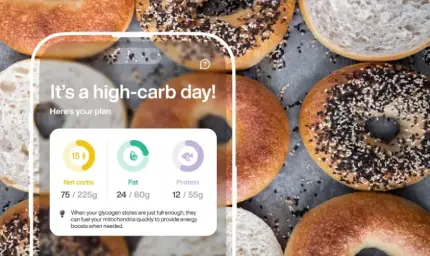Carb cycling for weight loss: A beginner’s guide


While we know that consuming too many refined carbs, such as white bread, pasta, and sugary snacks, may contribute to weight gain and other health problems, most of us eat these foods regularly. In fact, according to one study [1], low-quality carbs still account for 42% of daily calories, while high-quality carbs — such as whole grains and fruits — only account for 9%.
This is one of the many reasons carbs can be a controversial topic and why many diets eliminate them to help with weight management. Yet, cutting out carbs completely isn’t a solution because they’re necessary for sustainable weight loss.
You can still eat carbs and lose weight. It’s about balancing the quality, quantity, and timing of your carbohydrates and understanding how they impact your metabolism.
If you have a love-hate relationship with carbs, often enjoying them but feeling guilty or second-guessing yourself after eating them, you may be curious about the benefits of carb cycling. Let’s find out more.
Carb cycling is an eating pattern that alternates between high-carb and low-carb days. It’s not a diet but rather a way of eating that helps your mitochondria, the powerhouses of your cells, to easily shift between carb and fat burn.
High-carb days give your mitochondria the energy they need to power your workouts and replenish glycogen, the stored form of glucose in muscles and the liver. On low-carb days, your mitochondria rely on fat for fuel.
When your mitochondria are more resilient, moving between carb and fat burn, they become metabolically flexible. This has many benefits, including weight loss, better body composition, improved athletic performance, and balanced energy.
Carb cycling can influence insulin sensitivity, which is crucial for metabolic health and weight management. Insulin sensitivity refers to how effectively the body’s cells respond to the hormone insulin, which regulates blood glucose levels.
High insulin sensitivity means cells use blood glucose more efficiently, reducing the risk of conditions like type 2 diabetes. On high-carb days, increased insulin levels facilitate glucose uptake into muscle cells, promoting glycogen storage and muscle repair [2].
On low-carb days, reduced carbohydrate intake and lower insulin levels help the body rely more on fat for energy and may improve insulin sensitivity. This alternating pattern helps maintain balanced blood sugar levels, reduces insulin resistance, and supports overall metabolic health.
Carb cycling can also optimize glycogen levels to enhance performance and recovery. Glycogen plays a critical role in providing energy during physical activities.
On high-carb days, increased carbohydrate intake replenishes glycogen stores, ensuring muscles have ample energy for intense workouts and reducing muscle fatigue. During low-carb days, glycogen stores become depleted, prompting the body to use fat as an alternative energy source [3].
This cycle of glycogen replenishment and depletion boosts metabolic flexibility and promotes fat oxidation, which promotes weight loss.
You can structure your carb cycling in several ways. The most common method is alternating between low- and high-carb days, but you can also alternate between high- and low-carb weeks.
The amount of calories you eat daily or weekly depends on your goal. If you’re trying to lose weight, your daily intake should be at a caloric deficit [4]. If your goal is muscle growth, you will want to eat a surplus of macros daily, but make sure to balance your carbs and allow them to fit into your low- and high-carb days. Those who just want to balance their body composition or maintain their weight may find themselves somewhere in between.
Use a macro tracker to determine how many grams of carbohydrates you should eat based on your body weight. It may take some trial and error, but having a personalized nutrition plan based on your real-time metabolic biofeedback will remove the guesswork of understanding what your body needs to achieve your goals.
Here are some carb cycling tips from our Lumen experts:
Greek chicken salad
Ingredients
Chop, dice, and mix all the ingredients and enjoy!
Garlic salmon and broccoli
Ingredients
You can either air fry, bake, or cook the broccoli on the stove with a drizzle of olive oil. Chop the garlic, add it to a pan, and saute. Spread a generous amount of salt and pepper on the salmon and add to the pan with the garlic. Cook for 4 minutes on each side!

Chicken enchilada bowls
Chicken enchilada bowls
Saute the veggies and tofu or chicken. Cook the rice (about 1 cup). Once the veggies and meat are cooked, add them to one pan and drizzle teriyaki sauce on top. Mix in one bowl with the rice.
Carb cycling is one of the most effective ways to boost metabolic flexibility, burn fat, and lose weight. Having a personalized nutrition plan based on your real-time metabolic measurements will help you determine when your body needs a low- or high-carb day so you can stay on track with your health and weight loss goals.
[1] Shan, Z., Rehm, C. D., Rogers, G., Ruan, M., Wang, D. D., Hu, F. B., Mozaffarian, D., Zhang, F. F., & Bhupathiraju, S. N. (2019). Trends in Dietary Carbohydrate, Protein, and Fat Intake and Diet Quality Among US Adults, 1999-2016. JAMA, 322(12), 1178–1187. https://doi.org/10.1001/jama.2019.13771
[2] Daly, M., Vale, C., Walker, M., Alberti, K., & Mathers, J. (1997). Dietary carbohydrates and insulin sensitivity: A review of the evidence and clinical implications. The American Journal of Clinical Nutrition, 66(5), 1072–1085. https://doi.org/10.1093/ajcn/66.5.1072
[3] Murray, B., & Rosenbloom, C. (2018). Fundamentals of glycogen metabolism for coaches and athletes. Nutrition reviews, 76(4), 243–259. https://doi.org/10.1093/nutrit/nuy001
[4] Most, J., & Redman, L. M. (2020). Impact of calorie restriction on energy metabolism in humans. Experimental gerontology, 133, 110875. https://doi.org/10.1016/j.exger.2020.110875

Abigail Markman holds a Master’s degree in Nutritional Sciences, underscoring her vast knowledge of nutrition and health. She has been a practicing Nutritionist for several years, driven by her passion for empowering people with valuable insights into balanced nutritional intake and lifestyle habits and their significant role in promoting overall well-being.